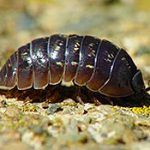Pillbugs belong to a family of woodlice, a terrestrial crustacean group in the order Isopoda. Unlike members of other woodlouse families, members of this family can roll into a ball, an ability they share with the outwardly similar but unrelated pill millipedes and other animals. It is this ability which gives woodlice in this family their common name of pill bugs or roly polies. The best known species in the family is Armadillidium vulgare, the common pill bug.
Woodlice in the family Armadillidiidae are able to form their bodies into a ball shape, in a process known as conglobation. This behaviour is shared with pill millipedes (which are often confused with pill bugs), armadillos and cuckoo wasps. This behaviour may be triggered by stimuli such as vibrations or pressure, and is a key defence against predation; it also serves to reduce water loss through respiration.
Because of their unusual yet non-threatening appearance, certain types of armadillidiids (typically Armadillidium vulgare) are kept as pets in areas such as the American South, typically among children. Among adults, they are often seen as unwanted (but essentially harmless) home pests. Keeping a pet pill bug requires a very moist habitat with limited light. They can live up to about three years.
Owners of pet tarantulas sometimes keep pill bugs as cage cleaners in the same habitat. The pill bugs eat faeces, mould, and leftovers. They are sometimes caught and fed to pets such as iguanas and other lizards, but this is not recommended since those animals might become poisoned.

